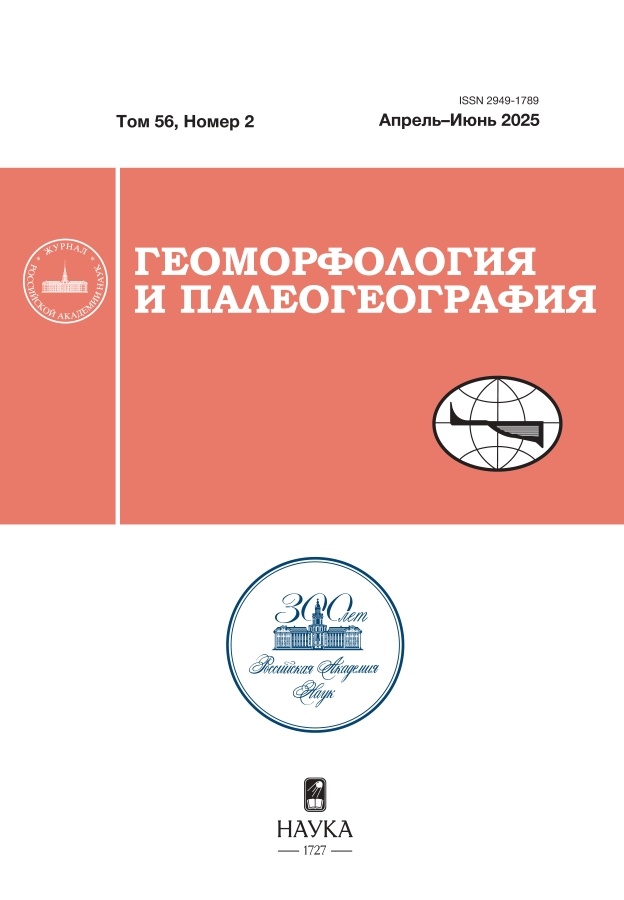Nival-corrosive wells of the southern Cis-Ural (features of distribution and formation)
- Authors: Smirnov A.I.1
-
Affiliations:
- Institute of Geology, UB RAS
- Issue: Vol 55, No 4 (2024)
- Pages: 144-156
- Section: EARTH SURFACE PROCESSES AND LANDFORMS
- URL: https://ruspoj.com/2949-1789/article/view/682345
- DOI: https://doi.org/10.31857/S2949178924040095
- EDN: https://elibrary.ru/FFRTOQ
- ID: 682345
Cite item
Abstract
It has been established that two main genetic types of wells are common in the region: karst-gravitational and nival-corrosive. The first ones are widely spread karst sinkholes, the second ones are rare negative landforms formed as a result of nival corrosion caused by snow melt water. The nival-corrosive wells are formed in gypsum of the Kungurian Stage of the Cisuralian Series of the Permian system in conditions of open (bare or Mediterranean) karst. The maximum distribution of such wells was recorded in two areas of karst gypsum outcrop in the watershed areas: Aurgazinsky – on the Pribelsk rolling and wavy plain and Seleuksky – in the western hilly foothills of the Southern Urals. In these areas, wells form karst fields. The density of wells per 1 km2 in such fields reaches 5 thousand. This is the highest occurrence of surface karst in the Southern Cis-Ural region. In the rest of the region, nival-corrosive wells are distributed singly and do not form karst fields, but they are also formed in places of karst gypsum outcrops on the surface of watershed spaces. The uniform morphology and morphometry of wells has been recorded everywhere, and their uniform confinedness to certain relief features has been established. With the general conditionally cylindrical shape of the wells, their average diameter is 5 m, and their depth is 10 m. Everywhere wells are formed in the valley-side flattened parts of the watershed spaces that abruptly adjoin steep slopes of river valleys. The determining factor in the formation of wells in different parts of the region are similar geological and geomorphological conditions of their places of distribution – the similar lithotype of karst gypsum outcroped on flat or slightly inclined surfaces of watersheds. The proposed mechanism for the formation of wells, caused by the activity of meteoric (mainly snow) waters, is given.
Full Text
##article.viewOnOriginalSite##About the authors
A. I. Smirnov
Institute of Geology, UB RAS
Author for correspondence.
Email: smalil@mail.ru
Russian Federation, Ufa
References
- Borisevich D.V. (1992). Urals Neotectonics. Geotektonika. № 1. P. 57–67. (in Russ.)
- Chernyaeva L.E., Chernyaev A.M., Mogilenskih A.K. (1978). Himicheskii sostav atmosfernykh osadkov (Ural i Priural’e) (The chemical composition of atmospheric precipitation (the Urals and Cis-Urals). Leningrad: Gosgeoltekhizdat (Publ.). 179 p. (in Russ.)
- Dublyanskij V.N. (1977). Karstovye peshchery i shakhty Gornogo Kryma (Karst caves and mines of the Crimean Mountains). Leningrad: Nauka (Publ.). 182 p. (in Russ.)
- Dublyanskij V.N. (2000). Zanimatel’naya speleologiya (Entertaining speleology). Chelyabinsk: Ural LTD (Publ.). 526 p. (in Russ.)
- Rozhdestvenskij A.P. (1971). Noveishaya tektonika i razvitie rel’efa Yuzhnogo Priural’ya (The latest tectonics and development of the relief of the Southern Urals). Moscow: Nauka (Publ.). 286 p. (in Russ.)
- Skvorcov G.G. (1962). Issues of engineering-geological study and assessment of karst at the base of railway structures. In: Spetsial’nye voprosy karstovedeniya. Moscow: AN SSSR (Publ.). P. 43–57. (in Russ.)
- Smirnov A.I. (2005a). Karst. In: Atlas Respubliki Bashkortostan. Pravitel’stvo Respubliki Bashkortostan. Ufa: Kitap (Publ.). P. 60. (in Russ.)
- Smirnov A.I. (2005б). Relief genetic types and landforms. In: Atlas Respubliki Bashkortostan. Pravitel’stvo Respubliki Bashkortostan. Ufa: Kitap (Publ.). P. 65. (in Russ.)
- Smirnov A.I. (2014). Open sulfate karst of the Southern Urals. Geologicheskii sbornik. № 11. P. 243–248. (in Russ.)
- Smirnov A.I. (2018). The sulphate karst map of the Southern Cis-Ural region (content, principles and mapping methodology). Inzhenernaya geologiya. V. XIII. № 1-2. P. 86-94. (in Russ.) https://doi.org/10.25296/1993-5056-2018-13-1-2-86-94
- Smirnov A.I. (2020). Modern karst sinkholes in the Southern Urals and Cis-Urals (within the borders of the Republic of Bashkortostan). Inzhenernaya geologiya. V. XV. № 4. P 42–53. (in Russ.) https://doi.org/10.25296/1993-5056-2020-15-4-42-53
- Smirnov A.I. (2023). Atypical types of karst in the Southern Urals and Cis-Urals. Geoekologiya. Inzhenernaya geologiya, gidrogeologiya, geokriologiya. № 3. P. 26–36. (in Russ.) https://doi.org/10.31857/S0869780923030104
- Smirnov A.I., Sokolov Yu.V. (2021). Isheevsky site is a unique karst-speleological object of the Southern Urals. Izvestiya Russkogo geograficheskogo obshchestva. V. 153. № 3. P. 63–75. (in Russ.) https://doi.org/10.31857/S086960712103006X
- Smirnov A.I., Sokolov Yu.V. (2022). Distribution of karst caves with perennial ice in the Southern Urals and in the Cis-Urals. Ice and Snow. V. 62. № 3. P. 363–376. (in Russ.) https://doi.org/10.31857/S2076673422030138
- Sokolov D.S. (1962). Osnovnye usloviya razvitiya karsta (The main conditions for the development of karst). Moscow: Gosgeoltekhizdat (Publ.). 322 p. (in Russ.)
- Timofeev D.A., Dublyanskij V.N, Kkiknadze T.Z. (1991). Terminologiya karsta (Karst terminology). Moscow: Nauka (Publ.). 259 p. (in Russ.)
- Yahimovich V.L. (1971). Geological development stages of the Bashkir Urals in the Neogene. In: Stratigrafiya neogena vostoka Evropeiskoi chasti SSSR. Moscow: Nedra (Publ.). P. 45–64. (in Russ.)
- Zverev V.P. (1967). Gidrogeokhimicheskie issledovaniya sistemy gipsy – podzemnye vody (Hydrogeochemical studies of the gypsum-groundwater system). Moscow: Nauka (Publ.). 99 p. (in Russ.)
Supplementary files

























